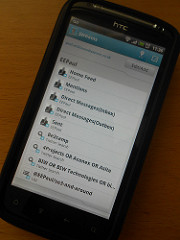The typical mobile phone these days has a 2 ¼” x 4 ¼” screen and a pop up keyboard. Most cost something close to $500-$750 and will soon move up to $1,000 – not counting cellular service. A very competent Windows laptop can be acquired for the same price and a powerful tablet computer can easily be obtained for a lot less.
For many of us a laptop or tablet, possibly with a supplemental monitor and keyboard, is our primary workstation. Most of us also accomplish much of our daily tasks using some type of cloud based solution, such as a CRM, financial system, document management system or email. So when we need to be mobile AND get work done, it’s no problem. But, how much of that work can we actually complete using only the ultimate mobile workstation, our expensive new phone?
Email, for starters, has been formatted appropriately for the phone so it is fairly convenient to read and respond. Long emails are not always easy to read if you have to scroll through a lot of backstory. CRM’s on a phone are also pretty good for basic information lookup and adding notes. Running contact reports and sending mass communication, not so much. Financial systems on a phone have limited utility, but some lookup and data entry is possible.
Document management at first glance seems like a long shot on a phone. Who wants to read an 80 page document on a tiny phone screen? As it turns out, actually reading the document end to end may not be the main use case or limiting factor. Typically, access to the document is for specific clarification or reference from just a page or two. Actually getting to the document is a far bigger challenge.
A useable mobile interface for efficient searching or browsing through folders is the real problem. In order to have enough context to know which document to open, sufficient meta data must be presented. If the results only show a long list of documents called “Contract” or “Sales Order”, it’s a problem. Contract must be further defined by information such as the vendor name and date of the document. Sales order needs to be accompanied by sales order number and customer name and so on.
Mobile solutions that want to provide users the ability to accomplish work on their phone starts with a well thought out interface. Like a mobile CRM, a mobile document management system can provide opportunities to get work done using a phone, but the use cases may be limited. Possibly immediate access to the exact terms of a customer contract are needed. Another use case would be workflow, where the user needs access to data and documents to make and submit a decision.
Workflow normally will incorporate an email notice and access to a review and approve interface. A well designed mobile solution will be able to provide that access so that your workforce in the field can be very efficient. The bottom line is that there is some work that can be accomplished on a phone. It is not likely to cover the entire job description, but work can get done. 
